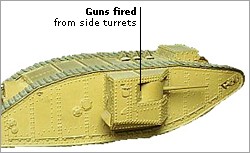DK History: World War I
World War I (1914–1918) was the first war in history to be fought by many different nations around the world. About eight million men were killed, many in horrific TRENCH WARFARE, before the ARMISTICE in 1918.
Table 56. WAR AND PEACE
| 1914 | Germany invades Belgium in order to attack France |
| 1915 | Gallipoli offensive in Turkey; Italy joins the Entente |
| 1916 | Naval battle off Jutland, Denmark |
| 1917 | US enters the war on the side of the Entente; Russia leaves the war; Italy defeated by the Austrians; Arabs revolt against Turks |
| 1918 | Armistice ends the war |
In the 20th century, European nations formed competing military alliances. War finally broke out in 1914 when a Serbian nationalist assassinated the heir to the throne of Austria. Austria went to war against Serbia, and many other countries joined in. On one side were the British, the French and Russian empires, Italy, and Japan (the Entente Powers). On the other side were the Germans, Austrians, Hungarians, Bulgarians, and Turks (the Central Powers).
Various new technologies were available. In 1915, the German army used poison gas for the first time in warfare, and it was soon in general use. The British were the first to introduce the battle tank. Submarines were now able to torpedo enemy shipping, forcing ships to travel across the ocean in convoys. Aircraft and airships were used to drop bombs, spy on enemy positions, and attack enemy pilots.
This was war on a scale never experienced before. It was not just fought by professional soldiers. Most of the troops were civilian conscripts, called up to serve in the armed forces. Ordinary homes in cities such as London were bombed from the air. Even ocean liners carrying passengers from neutral countries came under attack. Entire national economies were geared to the war effort.
Many young men on both sides of the conflict, who had been idealists in 1914, became horrified by the war and its cruelty. One of them was the English war poet Wilfred Owen, killed just a week before the Armistice.
In World War I, both sides dug long trenches as lines of defense, which stretched across Western Europe. These trenches filled up with stinking mud. Any order to go “over the top” and attack the enemy resulted in thousands of deaths.
The Gallipoli campaign between the Entente Powers and Turkey in 1915 included some of the worst trench fighting of the war. The campaign was a failure and cost the lives of many Australians and New Zealanders.
An armistice is a laying down of weapons. The guns of World War I finally fell silent at 11am on the 11th day of the 11th month of 1918.

